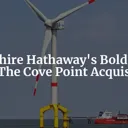Tags: history
This fanpage is not officially affiliated with Berkshire Hathaway: Disclaimer
We review the history of Berkshire Hathaway, exploring how it transformed from a struggling textile manufacturer to a global conglomerate under Warren Buffett's guidance.
We discuss the company's value investing philosophy, key acquisitions and investments, and the role of the American Tailwind in its success. Additionally, we touch upon Berkshire Hathaway's succession planning and lessons that can be learned from its remarkable growth story.

Early Beginnings
Berkshire Hathaway began as a struggling textile manufacturer in the early 20th century. The roots of the company can be traced back to 1839 when Oliver Chace founded the Valley Falls Company in Valley Falls, Rhode Island. Over the years, several mergers and acquisitions led to the formation of the Berkshire Hathaway we know today. In 1955, Berkshire Fine Spinning Associates and Hathaway Manufacturing Company merged to form Berkshire Hathaway Inc., a textile manufacturing firm.
It wasn't until the 1960s when a young investor named Warren Buffett took interest in the company. Initially, Buffett bought shares in Berkshire Hathaway because it was trading below its book value. However, as he gained control of the company, he started transforming it into the massive conglomerate that it is today.
Transformation Under Warren Buffett
When Warren Buffett took control of Berkshire Hathaway, he shifted the focus of the company from textiles to insurance. He recognized that insurance provided a steady stream of cash flow, which could be invested in other businesses or stocks. In 1967, Berkshire Hathaway acquired National Indemnity Company, marking its entry into the insurance business. Later, in 1996, it acquired GEICO, another major insurance company. These insurance companies became the backbone of Berkshire Hathaway's growth.
Value Investing Philosophy
Buffett's investment philosophy is centered around value investing. He believes in investing in businesses with strong fundamentals, competitive advantages, and competent management, all at a fair price. This long-term approach to investing has enabled Berkshire Hathaway to create a diversified portfolio of high-quality businesses, often referred to as a "collection of castles."
Key Acquisitions and Investments
Throughout its history, Berkshire Hathaway has made several key investments and acquisitions that have contributed to its success. We may list a few here:
-
National Indemnity Company: In 1967, Berkshire Hathaway acquired National Indemnity Company, marking its entry into the insurance business. As the company's first subsidiary, National Indemnity played a crucial role in building Berkshire Hathaway's insurance float, which has been vital to its growth.
-
GEICO: Berkshire Hathaway first invested in GEICO in the early 1950s and later acquired the company outright in 1996. This major insurance company has played a crucial role in Berkshire Hathaway's growth, generating significant profits and contributing to the conglomerate's financial strength and float creation.
-
Coca-Cola: Berkshire Hathaway purchased a 6.3% stake in Coca-Cola for $1.3 billion in 1988. As of 2023, this investment was worth around $25 billion, making it one of the most successful investments in the company's history.
-
Shaw Industries: Berkshire Hathaway purchased Shaw Industries, a leading carpet and flooring manufacturer, in 2001 for $2.1 billion. This acquisition helped diversify the conglomerate's portfolio and established a strong presence in the flooring industry.
-
Fruit of the Loom: In 2002, Berkshire Hathaway acquired Fruit of the Loom, a well-known apparel manufacturer, for $835 million. This acquisition allowed the conglomerate to enter the apparel industry and has since become a profitable part of its business.
-
Clayton Homes: Berkshire Hathaway acquired Clayton Homes, a leading builder of manufactured and modular homes, in 2003 for $1.7 billion. This acquisition expanded Berkshire Hathaway's presence in the housing industry and has been a valuable addition to its portfolio.
-
McLane Company: In 2003, Berkshire Hathaway acquired McLane Company, a wholesale distributor of groceries and non-food items, for about $1.5 billion. This acquisition expanded Berkshire Hathaway's reach in the wholesale distribution sector and has contributed positively to its overall earnings.
-
Burlington Northern Santa Fe Railroad: In 2009, Berkshire Hathaway acquired the majority of Burlington Northern Santa Fe (BNSF) for $34 billion, marking one of its largest acquisitions. This investment has since paid off, as BNSF has become a significant contributor to the conglomerate's earnings.
-
Precision Castparts: In 2016, Berkshire Hathaway acquired Precision Castparts, an aerospace and industrial components manufacturer, for $37 billion. This acquisition further diversified Berkshire Hathaway's portfolio and bolstered its presence in the aerospace industry.
-
Apple: Berkshire Hathaway first invested in Apple in 2016. As of now (Q1 / 2023), Berkshire holds around 5.8% of Apple's outstanding shares, making it one of the company's largest shareholders. This investment has been another major success, with the value of the stake growing significantly over the years.
| Investment | Year | Initial Investment | Value as of 2023-04-19 [1] |
|---|---|---|---|
| National Indemnity | 1967 | $8.6 million | N/A |
| GEICO | 1996 | $2.3 billion | N/A |
| Coca-Cola | 1988 | $1.3 billion | $25.4 billion [2] |
| Shaw Industries | 2001 | $2.1 billion | N/A |
| Fruit of the Loom | 2002 | $0.8 billion | N/A |
| Clayton Homes | 2003 | $1.7 billion | N/A |
| McLane Company | 2003 | $1.5 billion | N/A |
| Burlington Northern | 2009 | $34 billion | N/A |
| Precision Castparts | 2016 | $37 billion | N/A |
| Apple | 2016 | $33.5 billion | $149 billion [3] |
[1]: We may only provide market prices for the investments, i.e. non-subsidiaries. The value of the subsidiaries may be estimated using the annual reports from Berkshire Hathaway. Generally, the fair value of the subsidiaries is significantly higher than its acquisition price. For example, BNSF had earnings for about $6 billion in 2023, its acquisition price was $34 billion back in 2009.
[2]: Stockcircle: Warren Buffett's Transactions
[3]: Berkshire Hathaway's Apple Stake
The American Tailwind
The "American Tailwind" refers to the favorable economic conditions and environment that has enabled Berkshire Hathaway's success. The United States has a stable political and regulatory environment, access to capital markets, and a culture of entrepreneurship that has allowed businesses like Berkshire Hathaway to thrive. This "tailwind" has played a critical role in the company's growth, as it has been able to take advantage of opportunities in various industries, and continuously adapt to the changing economic landscape.
In short: Never bet against America -- Warren Buffett
The Role of Succession Planning
A major concern for Berkshire Hathaway's shareholders has been the issue of succession planning. Warren Buffett, now in his 90s, has been at the helm of the company for more than six decades. To address this concern, Berkshire Hathaway has put a succession plan in place. In 2018, the company appointed Greg Abel as Vice Chairman of Non-Insurance Operations and Ajit Jain as Vice Chairman of Insurance Operations. These appointments have ensured that Berkshire Hathaway's management will continue to operate smoothly and effectively, even after Buffett's eventual departure.
Lessons from Berkshire Hathaway's Success
Berkshire Hathaway's story offers several key takeaways for investors and businesses alike:
-
Long-term value investing: Buffett's value investing approach has proven to be a winning strategy. By focusing on the fundamentals of a business and investing for the long term, Berkshire Hathaway has been able to create a successful and diversified portfolio.
-
Patience: Berkshire Hathaway's success did not happen overnight. The company has shown great patience in its investment approach, allowing businesses to grow and compound over time. This patience has been crucial in its ability to ride the American Tailwind.
-
Adaptability: Berkshire Hathaway has consistently adapted to the changing economic landscape. By diversifying its portfolio across various industries, the company has been able to weather economic downturns and take advantage of new opportunities.
-
Strong management: A competent and visionary management team has been instrumental in Berkshire Hathaway's success. Buffett's leadership and the appointment of Abel and Jain have ensured that the company continues to operate effectively and maintain its growth trajectory.
Conclusion
Berkshire Hathaway has become a symbol of American capitalism and its ability to thrive in a constantly changing environment. By taking advantage of the American Tailwind, the company has built an impressive empire that continues to grow and prosper. Through strategic investments, long-term value investing, patience, and adaptability, Berkshire Hathaway has demonstrated the power of riding the wave of American economic growth. As shareholders of Berkshire Hathaway, one can take pride in being part of this incredible journey and the company's commitment to creating lasting value.












